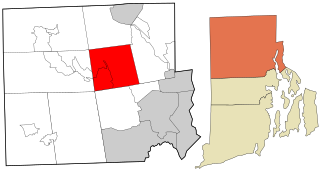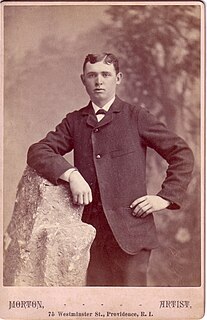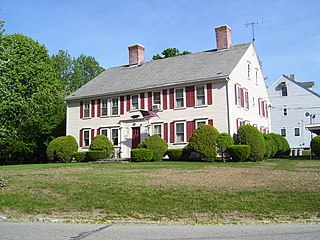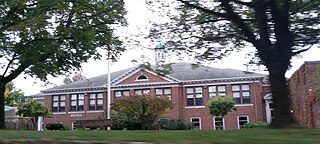
Greenville is a village and census-designated place (CDP) in the town of Smithfield in Providence County, Rhode Island, United States. The population was 8,658 at the 2010 census. The CDP is centered on the village of Greenville but also encompasses the nearby villages of West Greenville and Spragueville, as well as the Mountaindale Reservoir and beach.

North Smithfield is a town in Providence County, Rhode Island, United States, settled as a farming community in 1666 and incorporated into its present form in 1871. North Smithfield includes the historic villages of Forestdale, Primrose, Waterford, Branch Village, Union Village, Park Square, and Slatersville. The population was 12,314 at the 2015 census.

Smithfield is a town that is located in Providence County, Rhode Island, United States. It includes the historic villages of Esmond, Georgiaville, Mountaindale, Hanton City, Stillwater and Greenville. The population was 21,430 at the 2010 census. Smithfield is the home of Bryant University, a private four year college.
Daniel Mowry Jr. was an American cooper and farmer from Smithfield, Rhode Island. He served as a delegate for Rhode Island in the Continental Congress from 1780 to 1782.

Thomas Alexander Tefft was an American architect, from Providence, Rhode Island.

Arthur Wallace Steere (1865–1943) was a Rhode Island politician and prominent businessman and landowner.

The stone-ender is a unique style of Rhode Island architecture that developed in the 17th century where one wall in a house is made up of a large stone chimney.

The Beneficent Congregational Church is a United Church of Christ congregation of Congregationalist heritage at 300 Weybosset Street in downtown Providence, Rhode Island. The congregation was founded in 1743 during the "First Great Awakening".

Union Village or "Bank Village" is a village and historic district located in North Smithfield and Woonsocket, Rhode Island on Rhode Island Route 146A. Union Village developed because it was at the cross roads of old Great Road and Pound Hill Road.

The Peleg Arnold Tavern off Great Road in Union Village in North Smithfield, Rhode Island was built around 1690 and is one of the oldest homes in North Smithfield. The oldest part of house was built in the late 17th century by Richard Arnold, one of the earliest settlers in the area. His descendant, Peleg Arnold, greatly expanded the building a century later. Peleg Arnold was a justice of the Rhode Island Supreme Court and representative to the Continental Congress. Arnold's popular tavern served as center of American military operations in the town during the American Revolution. The house was added to the National Register of Historic Places in 1974.

Saint Thomas Episcopal Church is an Episcopal church located at 1 Smith Avenue in the village of Greenville in Smithfield, Rhode Island.

The Waterman–Winsor Farm is a historic farm house located in the Greenville part of Smithfield, Rhode Island.

The William Mowry House is an historic farm house on Farnum Pike in North Smithfield, Rhode Island. It is a 2-1/2 story plank-framed house, five bays wide, with a gable roof and a large central chimney. The main entrance is centered on the main (south-facing) entry, and is enclosed within a single-story hip-roof vestibule of 20th-century construction. A small single-story ell extends to the west of the main block. The interior follows a typical center-chimney plan, with the kitchen and parlor in the front of the house, and the dining room flanked by a small pantry and bathroom in the rear. The house was built c. 1802-05 by William Mowry, whose family has owned land in the area since the 17th century.

The Captain Stephen Olney House is a historic site in North Providence, Rhode Island. It is a 2 1⁄2-story wood-frame structure, five bays wide, with a pair of interior chimneys. The principal exterior decoration is in the front door surround, which features pilasters supporting an entablature and gable pediment. The house was built in 1802 by Stephen Olney, a veteran of the American Revolutionary War, on what was then a large farm. His descendants enlarged the house in the 1840s, adding an ell to the south.

The Roger Mowry Tavern, also known variously as the Roger Mowry House, Olney House and Abbott House, was a historic stone ender house, built around 1653, in Providence, Rhode Island. Roger Mowry was a constable and operated the only tavern in the town. The tavern also served as a government meeting place, church, and jail. It was originally constructed as a 1 1⁄2-story single room house with a chamber upstairs. By 1711 the house was expanded with a two-story lean-to by 1711. At unknown later date, the top of the roof of the original house was raised up further. The original portion of the house was restored by Norman Isham by 1895. The Roger Mowry Tavern was the oldest house in Providence until it was demolished in 1900.
Mowry House may refer to:

The William Winsor School is an historic elementary school in Smithfield, Rhode Island within the village of Greenville directly across from the Greenville Public Library. The school is named after William Winsor. As of 2017 the school may close due to a reconfiguration of the district.

William Winsor (1819–1904) was a philanthropist, town treasurer, bank officer, farmer, supporter of education, and co-founder of the Greenville Public Library. He was from Smithfield, Rhode Island where the William Winsor School was named after him.

Waterman Reservoir is a large lake along Putnam Pike in Glocester and Greenville in Providence County, Rhode Island.

























